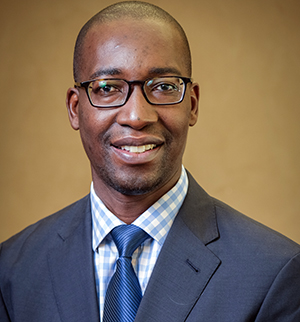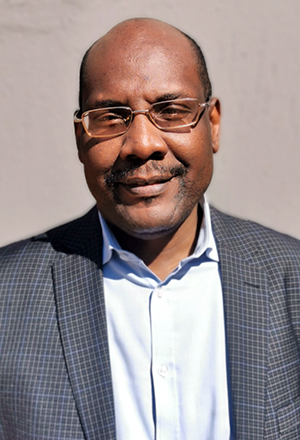News & Events
Examining King IV in the context of a transformed university
In line with the VC's vision for reclaiming and reimagining Africa's intellectual futures in the aftermath of the Covid-19 pandemic, the Department of Leadership and Transformation (DLT) hosted a roundtable discussion on 6 April 2022, entitled To what extent does King IV serve the culture of a transformed university?

Dr Malekutu Bopape, Deputy Director: Culture Change, DLT, briefly explained that the purpose of the roundtable discussion was to encourage debates in the university about its transformation agenda as it is articulated in the institution's Integrated Transformation Strategy and to address the following:
- Is King IV relevant to a 21st-century African university?
- Is the use of the King IV principles not ushering the corporatisation of HE institutions?
- Are there any other codes that can be used in a transformed university, based on non-Western contexts?

Dr Tapiwa Muzata
Dr Tapiwa Muzata, a doctoral fellow at Unisa and the keynote speaker, noted that ensuing from the temporal variable argument, transformation is one of the two temporal variables in this discussion. “It precedes the other variables in our consideration of governance in a transformed university,” he said. “The people who drive and/or operate within the governance systems or structures must understand the dynamics, needs, challenges and complexities of those who benefit from the yields expected from the governance systems or structures. This is the lacuna that transformation needs to deal with because the people behind the governance systems or structures must be diverse and understand the dynamics, needs, challenges and complexities encountered by the people they serve. It cannot be that one group of people (in terms of race, ethnicity, age, gender, and so forth) understands everyone they serve, while none or very few amongst them have experienced what it is to be part of the relevant race, tribe, gender, and so forth. Diversity in the serving group brings a plurality of experiences that enrich governance systems or structures installed to serve a diverse target audience.”
Muzata said that shareholder value maximisation ideology seems to dominate the design of the governance frameworks, even though societal and other factors are mentioned. “The primacy of owners of financial capital,” he continued, “is woven into the design of governance mechanisms rather than the primacy of social benefit guiding the design and operations of institutions. As such, the ideology needs to change to embrace transformation designed to serve systems that reflect societal demographics. I propose enabling transformed governance underpinned by the purposes of transformation and governance in a South African society which exemplifies extreme inequalities. The enabling transformed governance becomes a strategy to mitigate perpetuation of inequalities.”
University governance models in the literature
Muzata proceeded to discuss several governance models discoursed in the literature.
Model 1: The university as a bureaucracy
Bureaucracies are networks of social groups dedicated to limited goals, organised for maximum efficiency, and regulated according to the principle of "legal rationality" (rules, regulations and careful procedures) rather than friendship, loyalty to family or allegiance to a charismatic leader. The bureaucratic structure is described as hierarchical and tied together by formal chains of command and systems of communication.
Model 2: The university as a collegium
This is a more traditional model that recognises that a university is a community of scholars who focus on academic projects. It embraces the notion of shared governance. The university governance is managed by academic staff, and expansive governance powers are granted to the university's senate or substantial faculty representation on governance boards. A combination of these is also possible.
Model 3: The university as a political system
Crippling student protests, unionisation of professors and their strikes, strikes by organised labour representing administrative staff, and external stakeholders who want to exert influence on universities point to the propositions of this model. These aspects are considered political acts that arise from the complex fragmented social structure of the university, drawing on the divergent concerns and lifestyles of hundreds of subcultures.
Model 4: Corporate governance
This model focuses on the management of the university's finances, leadership, and the managerial responsibilities of those charged with governance. The model is premised on a business case model focusing on efficiency, financial management and the elimination of wasteful or fruitless expenditures. The university is run along corporate lines even though the motive is not profit.
Model 5: Trustee governance
This model places fiduciary responsibilities on trustees who are expected to act in utmost good faith on behalf of beneficiaries. The fiduciary duties bind both the board of trustees and individual trustees who are expected to exercise diligence and due care, protect the trust, and avoid conflicts of interests.
Model 6: Stakeholder governance
Stakeholder governance vests in assembling broad stakeholders including students, academics, support staff, industry, government, and the public in general. The mandates of the stakeholders who form the governance structure transcends efficient leadership and management, and fiscal responsibilities. The model is inclusive and attracts wider participation in the affairs of the university.
Model 7: Amalgam models of governance
This is a tailormade model that leverages the positives of other models.
Muzata concluded that a one-size-fits-all governance system is not advisable. “An honest evaluation of governance systems to genuinely move the university's core business forward and conducting a stakeholder mapping might help[LN1] ,” he said. “Universities need to find governance structures that amalgamate positives from various codes. The recommendation is for universities not to be tied to one code of governance, but to embrace positives from multiple codes.”

Dr Joel Baloyi
Dr Joel Baloyi, Deputy Registrar: Governance, responded to the keynote speaker by highlighting the importance of the regulatory framework in terms of Section 27 (1) of the Higher Education Act, which states that the councils of public higher education institutions must govern these institutions subject to this Act and the institutional statute. The Department of Higher Education and Training’s regulations for reporting by public education institutions of 2014, provide that in reporting, each institution is encouraged to comply with relevant standards of accountability as recommended by King III, King IV only commenced in 2017. Paragraph 7 (1) Institutional statute states that the function of the council is to govern the university in accordance with the provisions of the Act and generally recognised principles of good governance.
“The King Reports,” said Baloyi, “were formulated in the wake of the new democratic dispensation in South Africa to formulate an approach that reflects African needs and culture by incorporating concepts of sustainability and good citizenship. The King Reports were not formulated to address transformational objectives, they were rather concerned with the formulation of a governance framework that would best fit a post-apartheid environment. However, it cannot be said that the King Reports and King IV are anti-transformational. At least King IV is a framework of governance that depicts a certain admirable level and paradigm of positive evolution in the discipline of the governance of organisations that can be used with a degree of efficacy or effectiveness in the achievement of transformational aspirations while awaiting the development of a more responsive framework.”
In conclusion, Baloyi said that governance and transformation, and distinct, yet complementary objectives, must promote and advance transformational imperatives, and a transformational paradigm must inform the governing body's decision-making processes.
* By Gugu Masinga, Communication and Marketing Specialist, Department of Leadership and Transformation
Publish date: 2022-05-16 00:00:00.0

